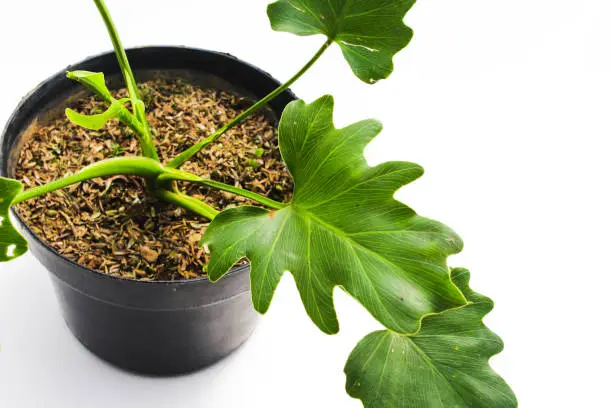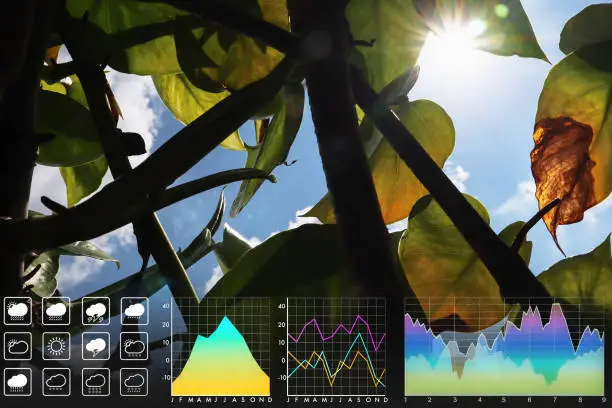The different types of Philodendron species contain a variety of dimensions, shapes, and hues, making them gorgeous preferences for indoor and outdoor settings. However, Philodendron, commonly known as Heartleaf, Sweetheart Plant, or simply Philodendron, belongs to the flowering plant family Araceae. Native to Central America and the Caribbean, its name derives from the Greek words “phileo”, meaning love, and “dendron“, meaning in botany is a tree, owing to its propensity to climb trees. Indoor gardens are incomplete without Philodendron plants. However, their lush greenery and striking appearance have made these plants popular with gardeners worldwide. They are known for their climbing or trailing vines and their ability to thrive in various indoor conditions.

The Different Types of Philodendron Plants
There are numerous Philodendron plants, each with unique characteristics and beauty[1] Nainwal, P., Review on Philodendron Species-Plant Seeking For Validation of Its Therapeutic Approaches. J. Pharm. Sci. & Res. Vol. 11(5), 2019, 2003-2006. Read. However, one of the most common types of Philodendron species is the Heartleaf Philodendron (Philodendron hederaceum). These heart-shaped leaves are ideal for hanging baskets and cascading shelves because of their vining habit.
Another popular variety is the Split-Leaf Philodendron (Philodendron bipinnatifidum), also known for its uniquely shaped leaves with deep cuts and holes.
Read: Rhaphidophora Hayi – Shingle Plant
Varieties of Philodendron species
- Philodendron hederaceum (Heartleaf Philodendron): A popular houseplant with solid, dark-green leaves around 5 inches long. The ‘Brazil’ variety stands out with a yellow band down the center of each leaf.
- Philodendron bipinnatifidum (Formerly P. selloum): Often reaching heights of 12-15 feet with equally extensive spread, this variety showcases deeply cut, green to dark green leaves up to 3 feet long. Well-suited to larger commercial spaces, it shares cultural requirements with P. hederaceum.
- Philodendron var. Xanadu: Compact hybrid perfect for homes, growing 2-3 feet tall with slender stems. Its narrow, shallowly lobed 6-12 inch leaves are versatile, thriving in both sun and shade.
- Philodendron speciosum: A rare find with entirely toothed margins on unlobed leaves. The inflorescence boasts a white spadix encased by a pink spathe.
- Philodendron evansii: An ornamental beauty with large lobed leaves, distinct from P. bipinnatifidum, showcasing colorful white inflorescence with pink edges.
- Philodendron bipennifolium: Compact and dark green, bears lobed leaves similar to P. bipinnatifidum.
- Philodendron stenolobum: Often mistaken for P. williamsii, its wavy, narrow leaves can reach 2-3 feet in length, with a slender trunk growing taller.
- Philodendron goeldii: Resembling P. schefflera, it features divided leaves, adding a unique touch to your collection.
- Philodendron ‘Soledad’: An intriguing unknown hybrid resembling P. vansii, ideal for a touch of mystery.
- Philodendron corcovadense: A petite species growing 3 to 4 feet tall, offering an understated charm.
- Philodendron erubescens (Red-leaf Philodendron): Triangle-shaped glossy leaves with a reddish tint underneath, matched by reddish-purple stems and leaves.
- Philodendron radiatum: Standout deep-lobed leaves extending up to 1 foot in length.
- Philodendron wilsonii: A large climber with lobed leaves measuring 2 to 3 feet, adding vertical interest to your space.
The types of Philodendron species offer a range of sizes, shapes, and colors, making them captivating choices for indoor and outdoor environments.
Popular Philodendron Varieties and Their Characteristics
Heartleaf Philodendron (Philodendron hederaceum) – The plant is easy to maintain, making it a common houseplant. However, Also, this tried-and-true favorite comes with lush green leaves and is easy to grow. Moreover, this variety is characterized by its heart-shaped leaves and trailing vines. It is a choice for beginners due to its low monitoring requirements and ability to flourish in various light conditions. Adaptable to different environmental conditions, it can tolerate a variety of conditions. Alternatively, let it climb a totem pole or hang in a basket.
Philodendron Hederaceum Flower Description – In cultivation, this plant is unusual because of its small, white flowers with an elegant spadix and spathe combined. The spadix and spathe intertwine, with the spathe forming a protective tube that gracefully expands into a greenish-yellow hood above the spadix.

Split-Leaf Philodendron (Philodendron bipinnatifidum) – The Split-Leaf Philodendron is known for its large, deeply lobed leaf structure that resembles Swiss cheese. Compared with heartleaf philodendron, it prefers higher humidity and medium-to-bright light levels. However, it is a stunning focal point in any room and requires bright, indirect light. Tropical landscape shrubs often grow this plant.

Lacy Tree Philodendron (Philodendron selloum) – This variety features large, deeply lobed leaves that give it a tropical and exotic appearance. However, it is a slow-growing Philodendron that prefers bright, indirect light and regular watering. Philodendron selloum does not climb like many other types of philodendron species. Monstera deliciosa and Thaumatophyllum bipinnatifidum are frequently confused with this plant.

Pink Princess Philodendron (Philodendron erubescens) – The Pink Princess is a rare and highly sought-after Philodendron variety known for its stunning pink and green foliage. It requires bright, indirect daylight and high humidity to maintain its vibrant colors.

Leaf Appearance and Features of Each Type
The diverse world of Philodendron plants presents an array of leaf shapes, sizes, and colors. From the Heartleaf’s small, dark green heart-shaped leaves to the Split-Leaf’s Swiss cheese-like lobes, each type carries a distinct charm. Lacy Tree Philodendron has a striking pink and green variegation, which is evidence that it contains terpenoids. Terpenoids are also found in other types of Philodendron species. This variety showcases nature’s artistic touch in botanical aesthetics.
| Philodendron Type | Leaf Characteristics | Appearance |
| Heartleaf Philodendron | Small, heart-shaped leaves; typically dark green [2] Explore more about Parlor Ivy (Heartleaf Philodendron). Read | Classic and simple |
| Split-Leaf Philodendron | Large, deeply lobed leaves resembling Swiss cheese | Intricately textured |
| Lacy Tree Philodendron | Large, glossy, deeply lobed leaves with a tropical flair | Dramatic and exotic |
| Pink Princess Philodendron | Striking pink and green variegated leaves | Unique and attention-grabbing |
Soil and Fertilization Requirements for Philodendrons
Philodendrons are relatively low-maintenance plants when it comes to soil and fertilization requirements. They prefer a well-draining potting mix that retains some moisture but stays waterlogged. However, a mixture of peat moss, perlite, and composted bark works well for Philodendrons. It is essential to allow the top inch of soil to dry out before watering and to avoid overwatering.
When fertilizing Philodendrons, a balanced liquid fertilizer can be applied every 4-6 weeks during spring and summer. However, avoid over-fertilization, as it can cause leaf burn.
Cultivation Essentials for Philodendrons
Soil: Flourish in loose, well-drained soil rich in organic matter. Ideal mediums include Sphagnum peat moss or peat-perlite ratio mixtures.
Fertilization: Philodendrons are heavy feeders. Regular nitrogen-based fertilization enhances leaf size and overall plant development. Frequent, half-strength feedings are preferable to single solid doses.
Fertilizer: During active growth, apply standard liquid fertilizer every 2-6 weeks for optimal results.
Watering: Consistent moisture in the potting mix is critical to even growth of large, uniform leaves. Avoid overwatering; ensure proper drainage to prevent root damage.
Light: Growing in bright, indirect daylight, Philodendrons exhibit a yellowish hue or sunburn spots with excessive exposure.
Temperature: Flourishing within 24-27ºC (75-80ºF) indoor temperatures, Philodendrons or any other indoor plant like pothos cannot survive below 13ºC (55ºF).

Exploring the therapeutic potential
Beyond its commonly known toxic nature, in-depth chemical investigations have uncovered an array of terpenoids and flavonoids in the plant’s composition. However, it is primarily recognized for its ornamental role in households.
Research suggests that having indoor plants like philodendrons can positively impact mental health and well-being. However, the presence of plants in indoor environments has been associated with reduced stress levels, increased focus, and improved mood[3]Korostenskij, I., Propagation, upkeep, and impact on mental health and classroom/workplace success of Dracaena trifasciata, Chlorophytum comosum, and Philodendron hederaceum. 2021. Read.
Read: Curly Spider Plant Propagation, Care, and Diseases
Exploring the silent features
Philodendron types widely cultivate worldwide as ornamental plants, primarily for their attractive flowering components. Although these plants are attractive, they also contain toxins that can cause health issues when ingested by household pets. Terpenoids are also found in many types of Philodendron species, which is an indication that the plants contain oils and resins.

Flavonoids and tannins are potential chemical constituents that could offer therapeutic benefits. However, its popularity as an ornamental species has somewhat overshadowed its medicinal potential.
Unseen Air Cleanser
Beyond aesthetics, Philodendron hederaceum doubles as a silent champion in air purification. As one of its specialties, it is excellent at eliminating formaldehyde from indoor spaces by up to 90%, especially from water-based paints, roofing materials, and carpet adhesives. This unassuming plant quietly takes on a role that contributes to healthier living environments.
Philodendron Plants Decor Home
Philodendron plants are incredibly versatile when displaying and styling them in your home. However, Philodendron hederaceum isn’t just confined to the indoor realm. Their trailing vines make them perfect for hanging baskets. They can also be placed on shelves or tabletops, allowing their greenery to cascade down and create a vibrant, lush display. However, it can spread its rich green allure as ground cover or embellish arbors and trellises, infusing a tropical vibe.
When selecting a location for your Philodendron, it is essential to consider its light requirements. Most Philodendrons prefer bright, indirect daylight, but some varieties can tolerate lower light conditions. Avoid placing your Philodendron in direct sunlight, which can burn the leaves. Additionally, ensure that your home’s temperature and humidity levels are suitable for the specific Philodendron variety you have chosen. Most notably in tropical and humid subtropical zones, it can be found on patios, windowsills, and poolside decks.
Final Thoughts on the Philodendron Plants
In conclusion, the world of Philodendron plants is vast and diverse, offering various options for plant lovers. From the classic Heartleaf Philodendron to the rare and unique Pink Princess Philodendron, each variety brings charm and beauty to any indoor interior. However, Philodendrons are relatively low-monitoring plants, making them an excellent choice for indoor gardeners.
Whether you hang them, place them on a shelf, or let them trail down from a tabletop, Philodendrons will beautify your interior space due to their natural beauty and greenery effect. So, why not start your journey of collecting Philodendrons?
References
| ↑1 | Nainwal, P., Review on Philodendron Species-Plant Seeking For Validation of Its Therapeutic Approaches. J. Pharm. Sci. & Res. Vol. 11(5), 2019, 2003-2006. Read |
|---|---|
| ↑2 | Explore more about Parlor Ivy (Heartleaf Philodendron). Read |
| ↑3 | Korostenskij, I., Propagation, upkeep, and impact on mental health and classroom/workplace success of Dracaena trifasciata, Chlorophytum comosum, and Philodendron hederaceum. 2021. Read |



